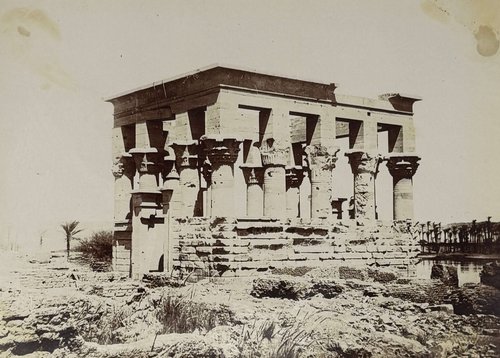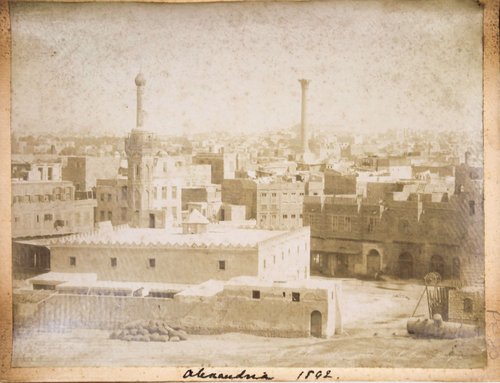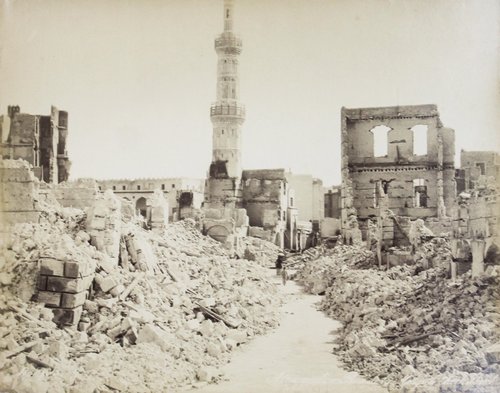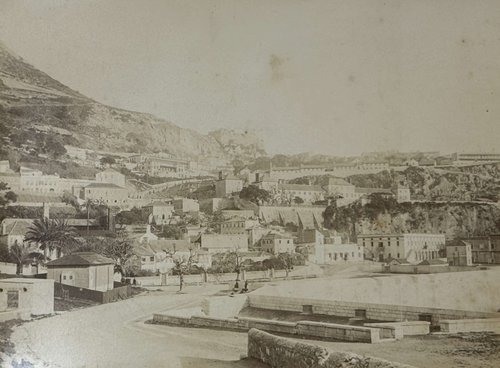



















#PA1_2
Ca. 1870s
Oblong Elephant Folio (ca. 45,5x62 cm). 22 leaves. With 21 albumen photographs, from ca. 23x30,5 cm (9x12 in) to ca. 18x25 cm (7 ¼ x 10 in), eight with numbers or markings in negative, three with clear signatures of Wilhelm Hammerschmidt in negative. First leaf with title in watercolour in French, and text in Egyptian hieroglyphs and cuneiform; armorial bookplate of Mr. Verdier de Latour on the title page. Attractive period dark brown quarter sheep with patterned and blind stamped papered boards with decorative borders on both boards and gilt lettered title “Album” and the initials V.[erdier de] L.[atour]. First paper leaf slightly waved and with minor damage on top and bottom of outer blank margin, not affecting the image, but overall a very good album of strong and sharp images.
Attractive collection of large early photos of the iconic sites of ancient Egypt and the Middle East, taken by some of their first photographers – Wilhelm Hammerschmidt and Maison Bonfils. Many photos show the famous architectural objects in their original state, i.e. The entrance to the Luxor temple half-buried in sand (before the large-scale excavations in the 1880s), the entrance to the Abu Simbel Temple also half-covered with sand and before its relocation in the 1960s due to the flooding the low-laying areas near Nile by the waters of the Lake Nasser; the Philae Island complex before it was flooded during the construction of the Aswan Low Dam etc. The photos most likely derive from the private collection of Michel Francois Verdier de Latour (1824-1879), chancellor of the French legations in Stockholm, China, and Berlin, French consul in Riga and Birmingham. The title page refers to Verdier de Latour’s special interest in Egypt and the Middle East, and the text written in Egyptian hieroglyphs and cuneiform may shed light on the circumstances of the compilation of the album.
The photos show: the Pyramid of Djoser at Saqqara (signed in negative “W. Hammerschmidt”); the Colossi of Memnon; Temple of Hathor at Dendera (signed in negative “W. Hammerschmidt”); three views of the Karnak complex (Obelisks in the Amun-Re Temple, the Gate of Ptolemy, a row of pharaoh statues); the columns of the Esna Temple (signed in negative “W. Hammerschmidt”); the entrance to the Luxor Temple with the obelisk and two sitting statues of Ramesses the Great, half-buried in sand (the excavation would not begin until 1884); the entrance to the Abu Simbel temple with the four colossal statues of Ramesses the Great half-buried in sand; two views the Philae Temple in its original state before the it was flooded by the Aswan Low Dam in 1902 (the double colonnade and the Trajan’s Kiosk); Nile’s First Cataract; ruins of the Bacchus Temple at Baalbec; Tombs of the Califs in Cairo; the Mosque of Sultan Hassan in Cairo; Jaffa from the sea (by Felix Bonfils); the Wailing Wall in Jerusalem; the Valley of Josaphat, and others.
“Born in Berlin, Wilhelm Hammerschmidt was already a professional photographer when he settled in Cairo, Egypt, around 1860. There he established the Hammerschmidt shop, where he sold photographic materials to other early photographers such as Henry Cammas. Hammerschmidt exhibited ten views of Egypt at the Société Française de Photographie in 1861 before becoming a member the following year. He also made costume and ethnographic studies, exhibiting those at the Exposition Universelle in Paris in 1867. Hammerschmidt also made photographs in Syria and Nubia, now Sudan” (Wilhelm Hammerschmidt / J. Paul Getty Museum online). Hammerschmidt is considered one of first photographers to produce high quality detailed images of Egypt and his travels and photographs of Upper Egypt and Nubia predate popular tourism in Egypt. He appears to have collaborated with the pioneering photo chemist Hermann Wilhelm Vogel (1834-1898) which would explain the high quality of Hammerschmidt's photographs.
Maison Bonfils was started by Felix Bonfils (1831-1885) in Beirut in 1867 and was "to become one of the most successful photographic businesses in the world. They photographed most of the important sights in the Middle East and their views were widely distributed" (Jacobsen p. 216). Bonfils' "stock had variety enough to please all and ranged from classical landscapes and biblical scenes to ethnographic portraits” (Perez, p. 141).



























